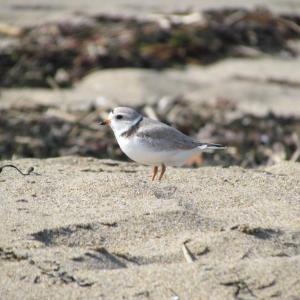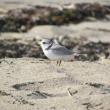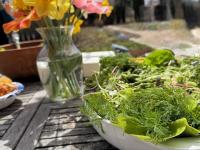Piping Up for Piping Plovers and Other Endangered Birds
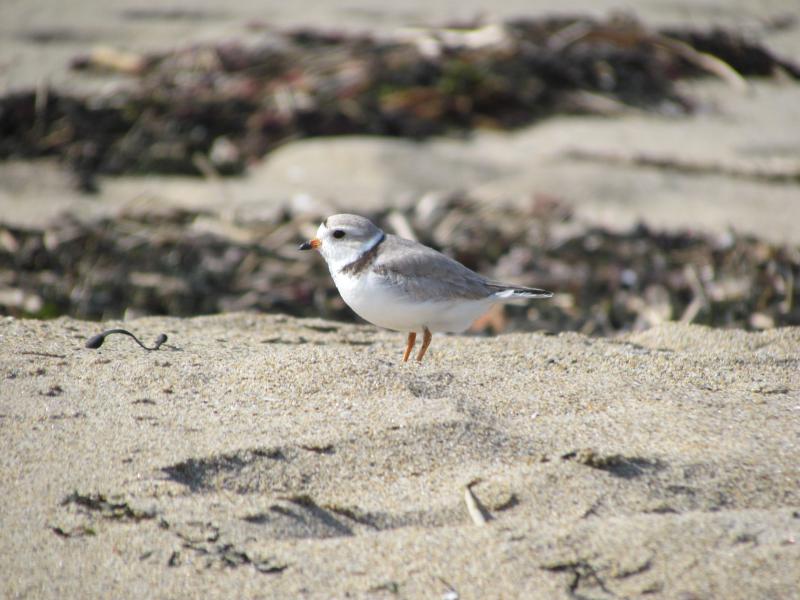 One of the elegantly beautiful piping plovers that we saw at Reid State Park over the weekend as we walked by at the waterline, away from the fenced-in areas where the bird is nesting. Photo by Jeff Wells.
One of the elegantly beautiful piping plovers that we saw at Reid State Park over the weekend as we walked by at the waterline, away from the fenced-in areas where the bird is nesting. Photo by Jeff Wells.
 No bothering to read the signs, one group of people who set up their day camp seemed oblivious to the fact that an endangered bird was attempting to nest only feet away. In this case, the bird sitting on a nest within the circular wire exclosure on the right side of the photo. Courtesy of Emma Bourget.
No bothering to read the signs, one group of people who set up their day camp seemed oblivious to the fact that an endangered bird was attempting to nest only feet away. In this case, the bird sitting on a nest within the circular wire exclosure on the right side of the photo. Courtesy of Emma Bourget.
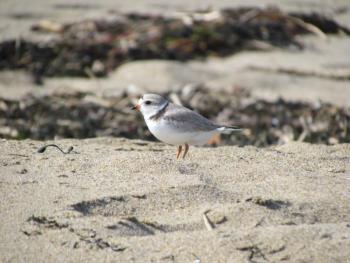 One of the elegantly beautiful piping plovers that we saw at Reid State Park over the weekend as we walked by at the waterline, away from the fenced-in areas where the bird is nesting. Photo by Jeff Wells.
One of the elegantly beautiful piping plovers that we saw at Reid State Park over the weekend as we walked by at the waterline, away from the fenced-in areas where the bird is nesting. Photo by Jeff Wells.
 No bothering to read the signs, one group of people who set up their day camp seemed oblivious to the fact that an endangered bird was attempting to nest only feet away. In this case, the bird sitting on a nest within the circular wire exclosure on the right side of the photo. Courtesy of Emma Bourget.
No bothering to read the signs, one group of people who set up their day camp seemed oblivious to the fact that an endangered bird was attempting to nest only feet away. In this case, the bird sitting on a nest within the circular wire exclosure on the right side of the photo. Courtesy of Emma Bourget.
Like many people on the recent very warm, sunny Memorial Day weekend, we decided to head to the beach, where the temps were markedly cooler. We went to a spot that is a favorite of many Mainers including ourselves, Reid State Park, at the end of the Georgetown Peninsula. As we strolled down the path toward the beach at the Todd’s Point side (note that construction has closed portions of the park so check the official park website before visiting), we passed signs reminding us that we would be sharing the beach with a state endangered species, the piping plover.
In February of this year, we engaged in some work to let state legislators know of the importance of supporting a bill that updated the state endangered/threatened species list (it had not been updated in eight years) to include some new species. Fortunately, the bill moved easily through Maine’s House and Senate and was signed by Governor Mills earlier in May. The bill adds saltmarsh sparrow, a bird that nests in the saltmarshes behind the beaches at Reid State Park, to Maine’s list of endangered species.
Other birds added to the state list under the category of “threatened” include bank and cliff swallows, blackpoll warbler, and Bicknell’s thrush.
Interestingly, the IUCN-BirdLife International Red List of species of conservation concern at the global level includes some Maine bird species that are not on Maine’s endangered/threatened list. Under the category of Vulnerable, the Red List includes long-tailed duck and horned grebe, both of which winter along our coast. This list also includes chimney swift, Leach’s storm-petrel, evening grosbeak, and rusty blackbird that nest in the state. The next category down on the Red List, the Near Threatened birds, includes other Maine species that are not on our state’s official endangered/threatened list, like common eider, eastern whip-poor-will, olive-sided flycatcher, eastern meadowlark, and common grackle.
These are just a few examples of ways that conservationists assess the conservation status of species. Endangered/threatened species lists that are mandated by legislation, like the federal U.S. Endangered Species Act or Maine’s Endangered Species Act, have the specific purpose of recognizing species that are in danger of extinction or at least at risk of disappearing from the boundaries of the nation or state. Neither list claims to be inclusive of all species that are in danger but the hope is that many of the most endangered and threatened species will be identified, and that more resources and attention will be focused on reversing their declines and bring them back to self-sustaining population levels.
That certainly has happened with the piping plover—the entire Atlantic coast population has more than doubled since the 1980s. Here in Maine, numbers went from six pairs in 1983 to 140 pairs in 2022. This incredibly exciting result is the result of a massive effort to reduce the impact of human activity and predators to allow the birds to raise young in the only place that they can: the very beaches that humans love to use for recreation.
On our recent visit to Reid State Park, we were fortunate to see several piping plovers as we strolled down the beach, staying closer to the waterline and away from the fencing and signs on the upper beach that indicated places the birds were using for nesting. We were dismayed to see one person who had placed his towel right up against one of the string fence. In a nearby section, a woman ducked underneath and went inside the fencing to grab a piece of driftwood. Farther down on the back side of the dunes, a group of about 20 people had set up a tent and towels close to the circular wire fence that clearly indicates an endangered bird species was nesting within it.
We remembered the story of a child, years ago, who had brought back some beautiful eggs to show their mother at Reid State Park—eggs from one of the few piping plovers that nested there at the time. Clearly a child is not to blame for indulging a natural curiosity, but all of these examples show what an endangered bird is up against, in addition to issues like rising levels, storms that can wipe out nests, and increased numbers of predators that are attracted to garbage people are responsible for at beaches.
Piping plovers and all of the species that are on endangered/threatened lists, as well as those on other lists of conservation concern, need every bit of help we can provide to make sure that they don’t disappear from our state, our nation, or our world. It can start with something as simple as choosing a different place to set up a towel or tent.
Jeffrey V. Wells, Ph.D., is a Fellow of the Cornell Lab of Ornithology and Vice President of Boreal Conservation for National Audubon. Dr. Wells is one of the nation's leading bird experts and conservation biologists. He is a coauthor of the seminal “Birds of Maine” book and author of the “Birder’s Conservation Handbook.” His grandfather, the late John Chase, was a columnist for the Boothbay Register for many years. Allison Childs Wells, formerly of the Cornell Lab of Ornithology, is a senior director at the Natural Resources Council of Maine, a nonprofit membership organization working statewide to protect the nature of Maine. Both are widely published natural history writers and are the authors of the popular books, “Maine’s Favorite Birds” (Tilbury House) and “Birds of Aruba, Bonaire, and Curaçao: A Site and Field Guide,” (Cornell University Press).

